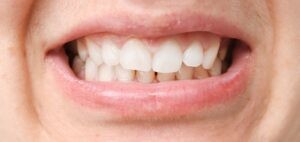The UK soft drinks industry has a market value of £16 billion, with carbonated drinks the largest sector at 40%. As such, in 2021, the UK consumed 14,520 million litres of soft drinks, averaging at around 105 litres per person.[i] Clinicians should consider the effects this may be having on their patients’ oral health, and the ways in which this can contribute to tooth wear. They must also acknowledge the ways that acting early could help prevent severe tooth wear, tooth fracture, and tooth loss.

Causes of tooth wear
To understand the nature of tooth wear, it’s important to understand its potential causes. This enables clinicians to manage the problem and advise their patients. Usually caused by a combination of chemical and mechanical factors, tooth wear is the cumulative loss of tooth structure. It is a natural part of ageing, but severe tooth wear may cause poor aesthetics and affect the teeth’s lifespan.[ii]
Research suggests that increased tooth wear is caused by extrinsic acid from food, drinks, and medications. This is as well as intrinsic acids, caused by gastro-oesophageal reflux and vomiting. The potential for extrinsic acids to erode the teeth is determined by many factors including:
This being said, acidic drinks have proved to be particularly harmful when it comes to tooth erosion. As such, clinicians should promote a healthy and balanced diet, with a reduced intake of acidic drinks.ii
Chronic trauma from occlusion may occur if abnormal forces are exerted on the tooth for a long period of time. Functional and occlusal issues such as teeth clenching can result in high-pressures being put on the teeth. As a result of this, the pressure on the tooth surface can cause wear, cracks, and fractures.[iii]
The effects of mechanical wear can be made worse by chemical erosion.i This is because acid can either erode the tooth structure directly, or soften the tooth. This leaves it susceptible to being worn away by hard toothbrushing or teeth grinding together.[iv]

The true cost of tooth wear
In 2022, UK households spent approximately £2.9 billion on dental care.[v] Tooth wear is common, with the chemical-mechanical process affecting 30% of adults.[vi] 2% of adults had severe tooth wear (exposing the pulp or secondary dentine), and 15% had moderate wear. This common condition can have an impact on patients, and it is importent to act early to prevent progression.ii
Not only does dental care impact patients financially, but tooth wear alone can lead to further dental issues. Sensitivity is a frequent complaint from patients with tooth wear, with 60% of patients reporting this symptom.ii In severe cases of tooth wear, dental pulp can be exposed, and become infected – this can result in the need for endodontic treatment.[vii] Other times, although it is becoming less frequently practised, extraction is necessary.vii
Taking action early to prevent fracture
Tooth fracture or loss are worst case scenarios here. So, pre-empting any issues with occlusion and function is key to prevent tooth wear. Clinicians should make recommendations and provide treatment to improve occlusion and function. In some cases, orthodontic or restorative treatment is necessary.
To properly examine a patient’s oral health status, and adjust their occlusion, it’s important to obtain accurate models of their anatomy. This allows clinicians to plan treatment effectively. As digital dentistry continues to evolve, accuracy is improving. Tools currently on the market, such as intraoral scanners, are not always appropriate for measuring occlusion. This is because they cannot accurately recreate the bite. Analogue dental impression materials are still considered the gold standard for obtaining an accurate representation of the anatomy.
While it is very common, and part of the natural ageing process which comes with wear and tear, tooth wear is an area of concern for many patients. When patients experience significant tooth wear earlier in life, clinicians should take action.

Stephen Claffey Managing Director of Dental Pathway™ and the Independent Dental Advisory Board™
[i] O’Sullivan, Elizabeth. “Tooth wear in children: prevalence, presentation and prevention.” Dental Update 50.10 (2023): 884-889. https://www.dental-update.co.uk/content/paediatric-dentistry/tooth-wear-in-children-prevalence-presentation-and-prevention/
[ii] Gov.uk. Chapter 7: Tooth wear. Accessed February 24. https://www.gov.uk/government/publications/delivering-better-oral-health-an-evidence-based-toolkit-for-prevention/chapter-7-tooth-wear
[iii] Uskudar Dental Hospital. What causes tooth fracture? Accessed February 24. https://uskudardishastanesi.com/en/what-causes-tooth-fracture
[iv] Leeds Teaching Hospitals NHS Trust. Tooth Wear. Accessed February 24. https://flipbooks.leedsth.nhs.uk/LN002840.pdf
[v] Statista. Annual household expenditure on dental services in the United Kingdom from 2005 to 2022, based on volume. Accessed February 24. https://www.statista.com/statistics/301054/annual-expenditure-on-dental-service-in-the-united-kingdom-uk
[vi] Marro, F., Jacquet, W., Martens, L., Keeling, A., Bartlett, D. and O’Toole, S., 2020. Quantifying increased rates of erosive tooth wear progression in the early permanent dentition. Journal of dentistry, 93, p.103282. https://www.sciencedirect.com/science/article/abs/pii/S0300571220300166
[vii] British Society for Restorative Dentistry. Tooth Wear Guidelines for the BSRD. Accessed February 24. https://www.bsrd.org.uk/File.ashx?id=15192